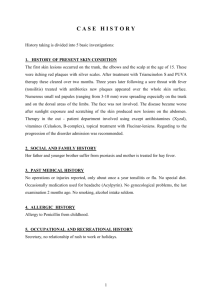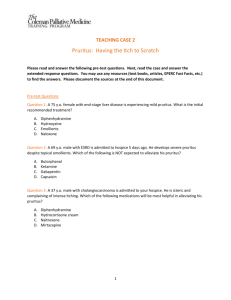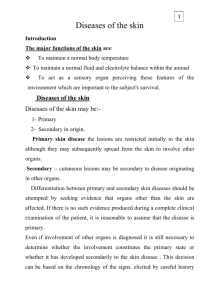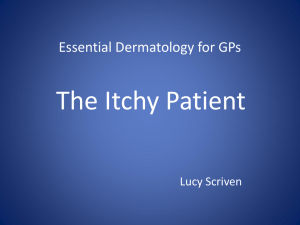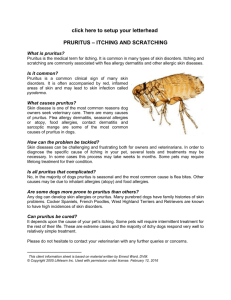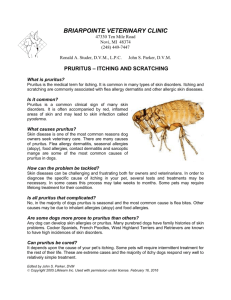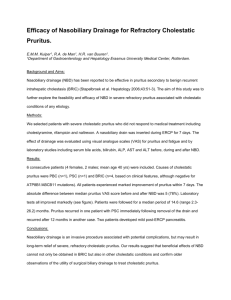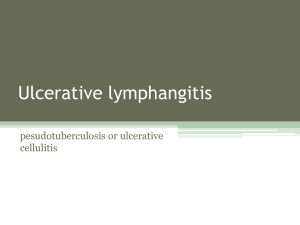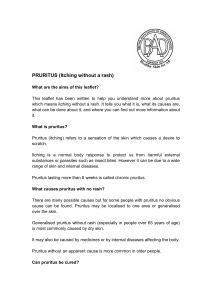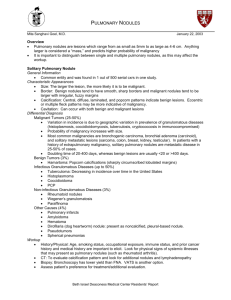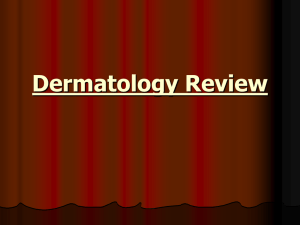Prurigo
advertisement
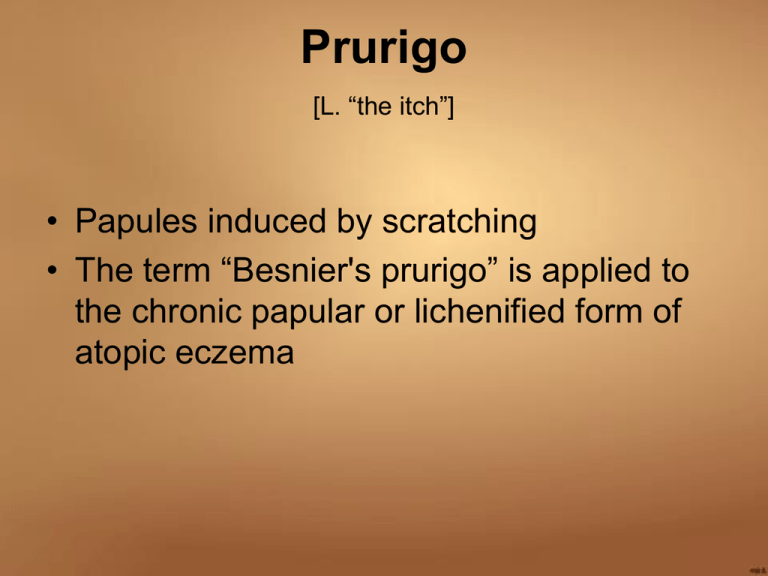
Prurigo [L. “the itch”] • Papules induced by scratching • The term “Besnier's prurigo” is applied to the chronic papular or lichenified form of atopic eczema Nodular Prurigo (Prurigo Nodularis) Etiology • The cause is unknown • Emotional stress seems to be a contributory factor in some cases • In 20% the condition starts after an insect bite • There is increase in number of neutrophils, mast cells, Merkel cells and IL-31 Clinically • Patients are mostly middle-aged to elderly • They complain of a long-standing history of severe, unremitting pruritus and they can point out specific sites where they began feeling itchy • The patient's medical history may reveal hepatic or renal dysfunction, local trauma to the skin, infection, anxiety or other psychiatric condition • The early lesion is red, and may show a variable urticarial component • All lesions are pigmented • Crust and scale may cover recently excoriated lesions, and there is an irregular ring of hyperpigmentation immediately around the nodules • The lesions are usually grouped, and numerous, but vary in number • They usually develop initially on the distal parts of the limbs & are worse on the extensor surfaces • There are crises of pruritus of intense severity • New nodules develop from time to time, and existing nodules may remain pruritic indefinitely, although some may regress spontaneously to leave scars. The disease runs a very protracted course Treatment • Local applications are of little value, but direct injection of the nodules with a steroid such as triamcinolone is often helpful • Thalidomide is probably the most effective treatment, if it is not contraindicated by the risk of pregnancy • Menthol, capsaicin cream, and topical anesthetics are some other topical agents used to reduce pruritus • Cyclosporin, azathioprine and topical capsaicin have been used with success in some cases • UV-B or PUVA may be beneficial for severe pruritus • A thorough assessment of the patient's emotional state is desirable, and tranquillizers may provide relief in some cases • Surgical Care –Cryotherapy with liquid nitrogen helps reduce pruritus and flatten lesions – Pulsed dye laser therapy may help reduce the vascularity of individual lesions. Erythroderma • It is a scaling erythematous dermatitis involving 90% or more of the cutaneous surface Etiology • • • • • The most common causes of ED are (ID-SCALP(: Idiopathic(red man syndrome) - 30% Drug allergy(Allopurinol, aspirin, anticonvulsants, barbiturates, captopril, cefoxitin, chloroquine, chlorpromazine, cimetidine, lithium, griseofulvin, nitrofurantoin, omeprazole) - 28% Different types of eczema - 15% Lymphoma and leukemia - 14% Psoriasis - 8% Less common causes • • • • • Dermatophytosis Lichen planus Lupus erythematosus Pityriasis rubra pilaris Pemphigus foliaceus and pemphigoid • An increased skin blood perfusion occurs resulting in heat loss and hypothermia and possible high-output cardiac failure • Fluid loss by transpiration is increased. The situation is similar to that observed in patients following burns (negative nitrogen balance characterized by edema, hypoalbuminemia, loss of muscle mass) • A marked loss of exfoliated scales occurs that may reach 20-30 g/d. This contributes to the hypoalbuminemia commonly observed in ED. Hypoalbuminemia results, in part, from decreased synthesis or increased metabolism of albumin • Edema is a frequent finding, probably resulting from fluid shift into the extracellular spaces Clinically • Patients may have a history of the primary disease (e.g. psoriasis, atopic dermatitis) or drug use • Pruritus is a prominent and frequent symptom and commonly results in excoriations. Malaise, fever, and chills may occur • Patients often present with generalized erythema • Scaling appears 2-6 days after the onset of erythema, usually starting from flexures • When ED persists for weeks, hair may shed; nails may become ridged and thickened and also may shed • Periorbital skin may be inflamed and edematous, resulting in ectropion • Idiopathic ED is characterized by marked palmoplantar keratoderma, dermatopathic lymphadenopathy, and a raised level of serum IgE and is more likely to persist than other types • Residual signs of the original disease may be found e.g.: - Islands of sparing in PRP - Few typical psoriatic plaques in psoriasis - Papules or oral lesions of lichen planus - Superficial blisters of pemphigus foliaceus Investigations • If the cause of ED is in doubt, survey patients for occult tumors • Primary disease may be evident by skin biopsy Treatment • Discontinue all unnecessary medications. Carefully monitor and control fluid intake, since patients can dehydrate or go into cardiac failure; monitor body temperature, since patients may become hypothermic • Apply tap water–wet dressings (made from heavy mesh gauze); change every 2-3 hours. Apply intermediate-strength topical steroids (e.g. betamethasone) beneath wet dressings • Suggest a tepid bath (may be comforting) once or more daily between dressing changes. Reduce frequency of dressings and gradually introduce emollients between dressing applications as ED improves • Use systemic antibiotics if signs of secondary infection are observed • Antihistamines help reduce pruritus and provide needed sedation • Systemic steroids may be helpful in some cases but should be avoided in suspected cases of psoriasis and staphylococcal scalded skin syndrome • Ensure adequate nutrition with emphasis on protein intake
